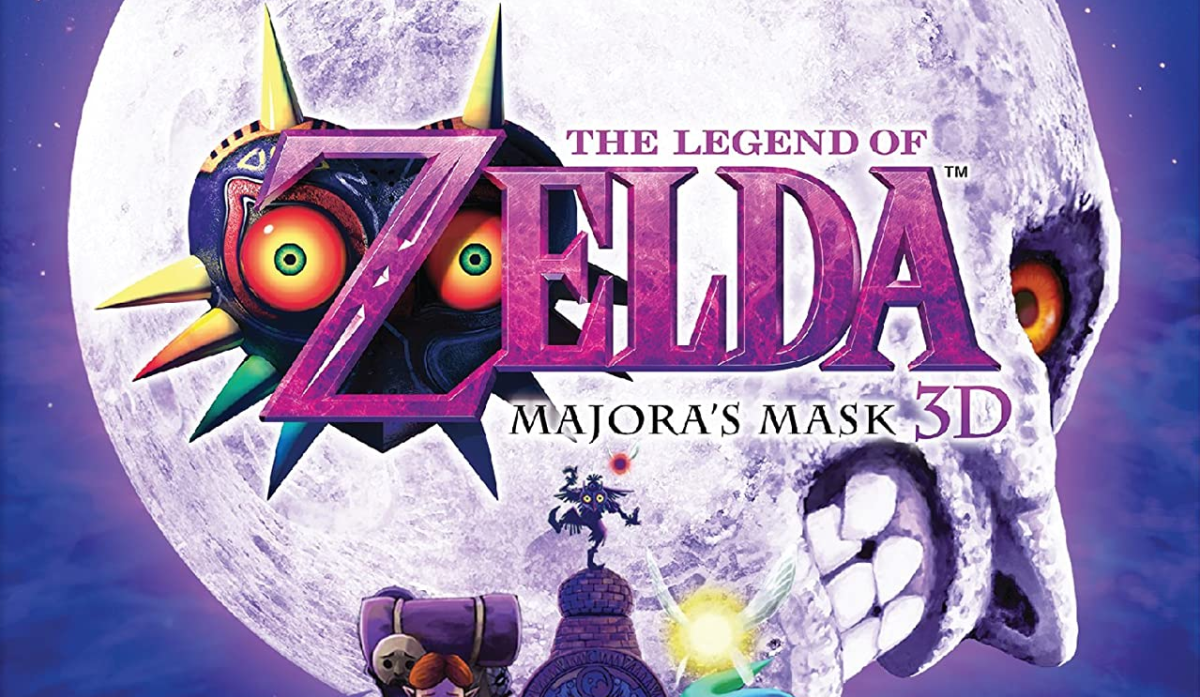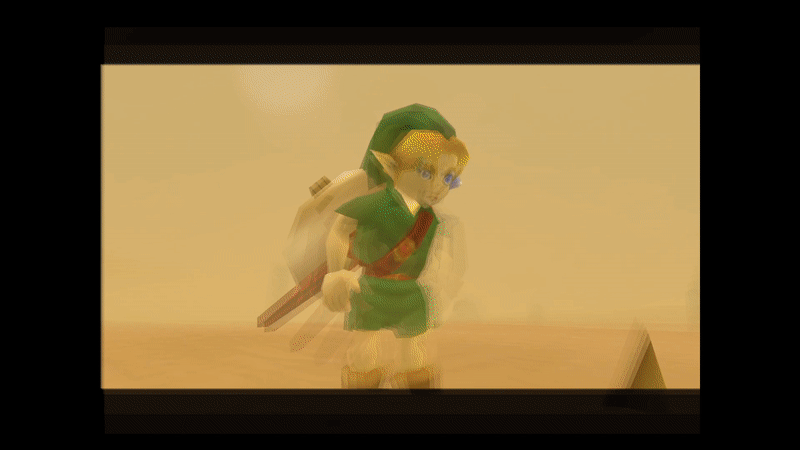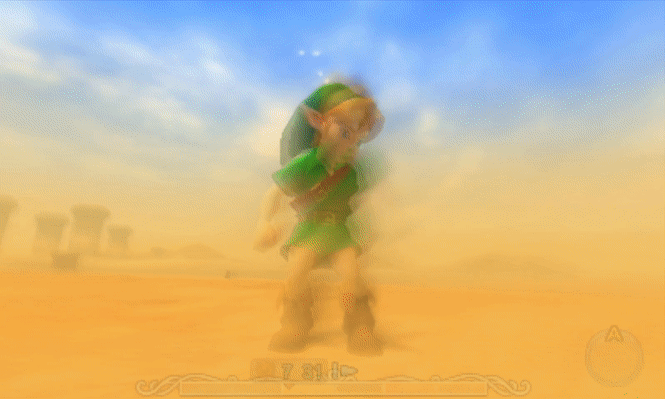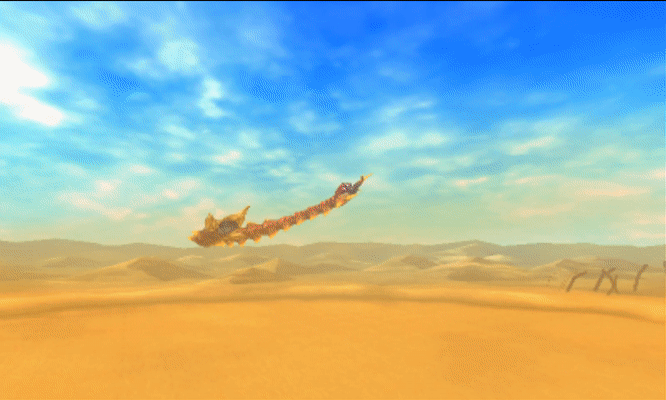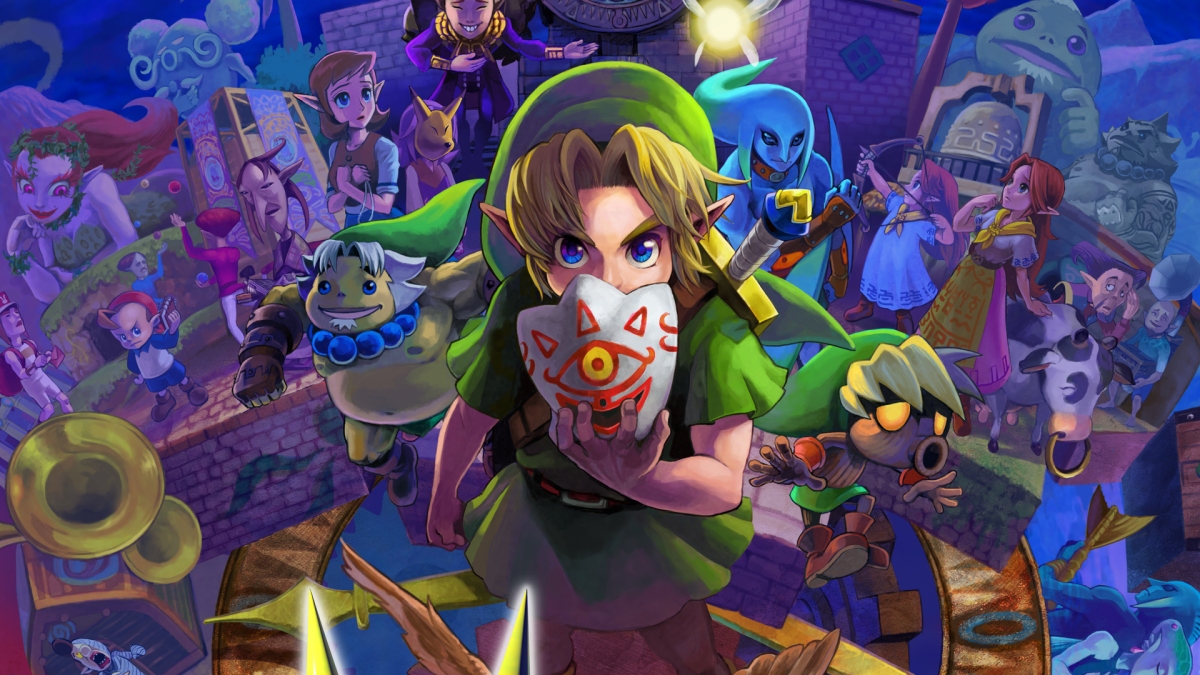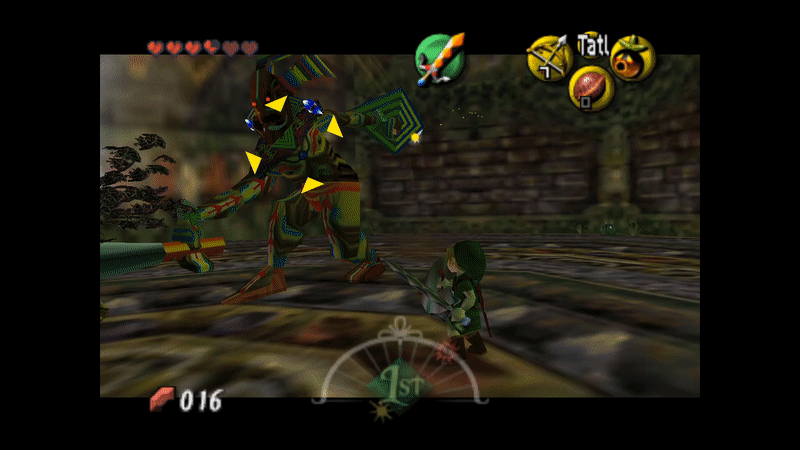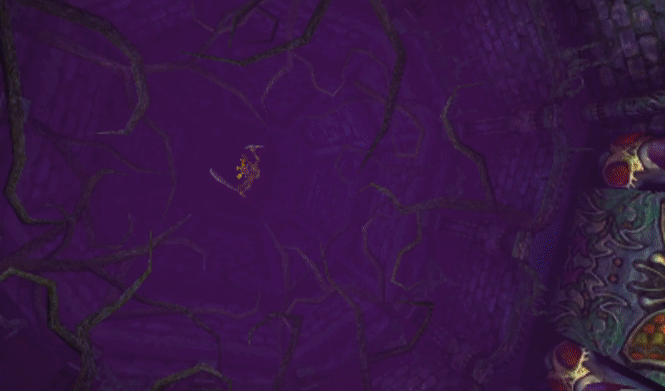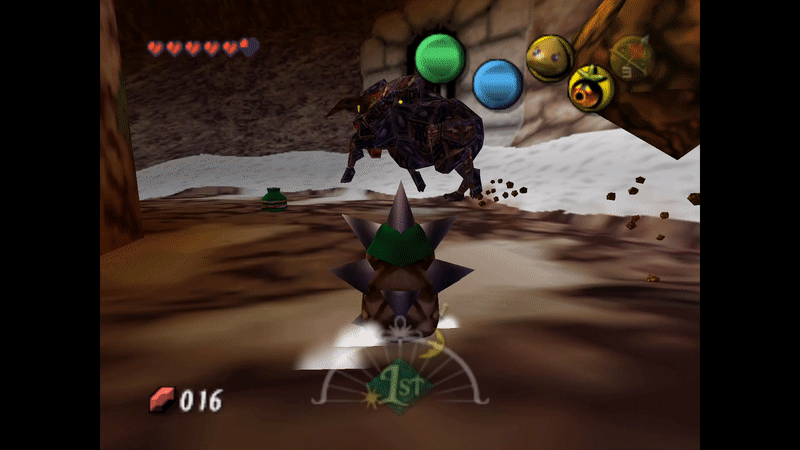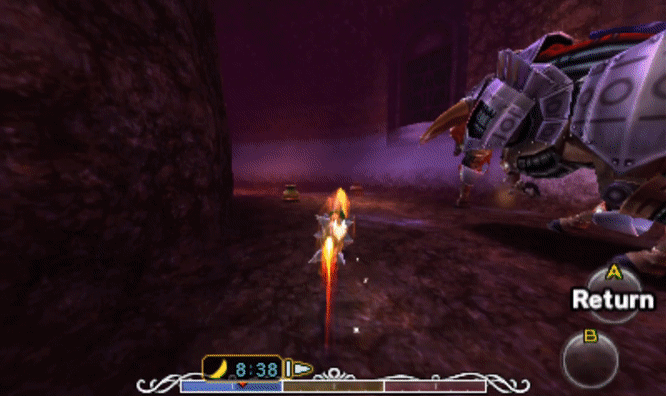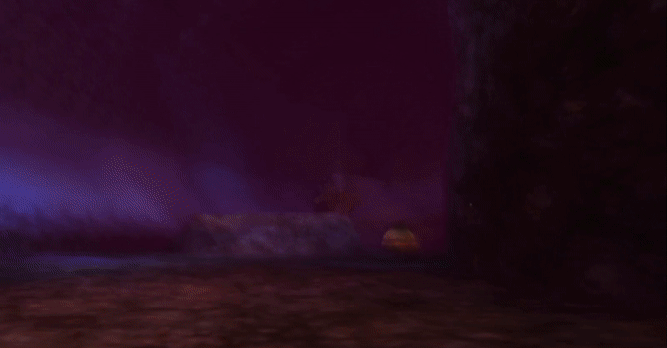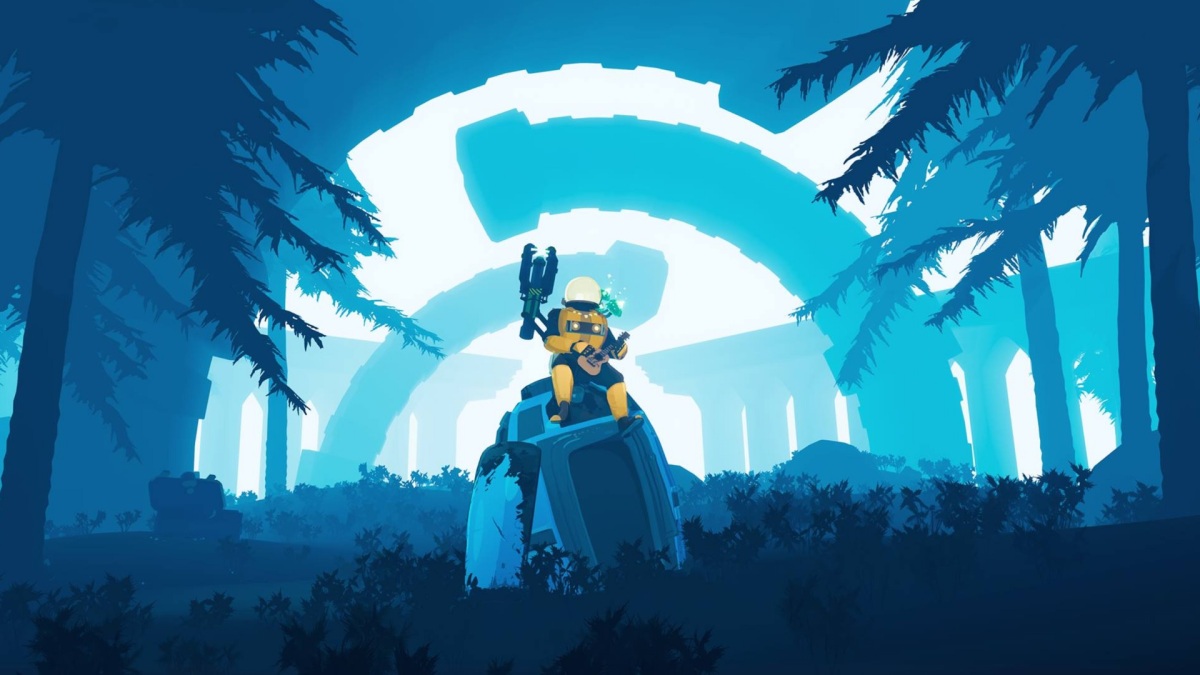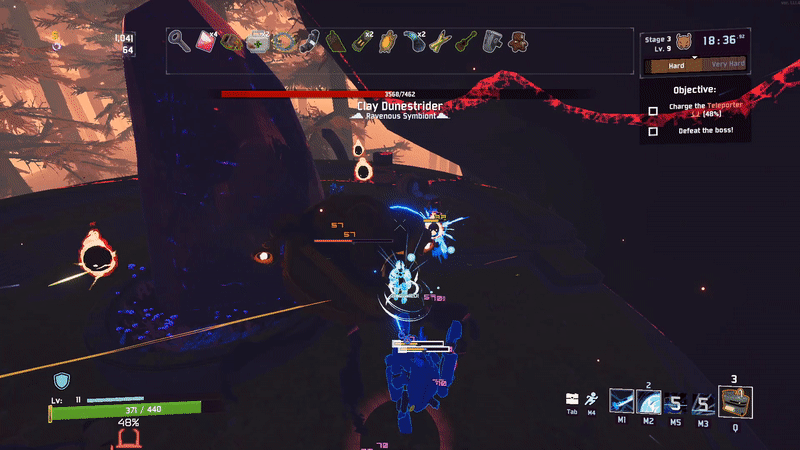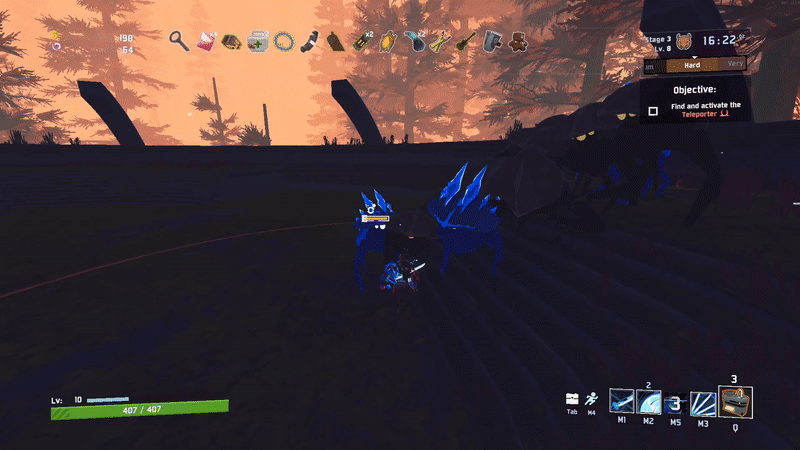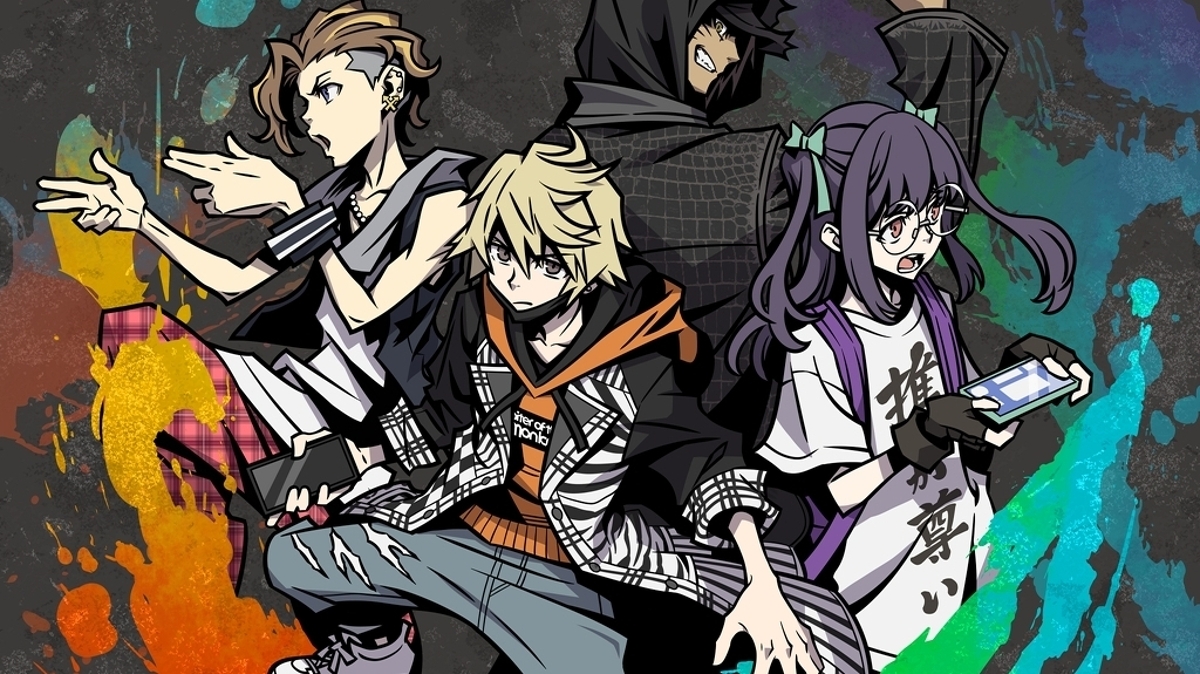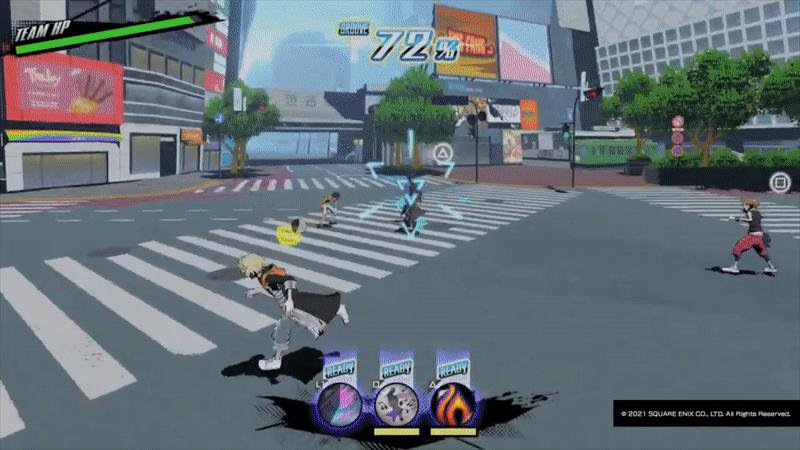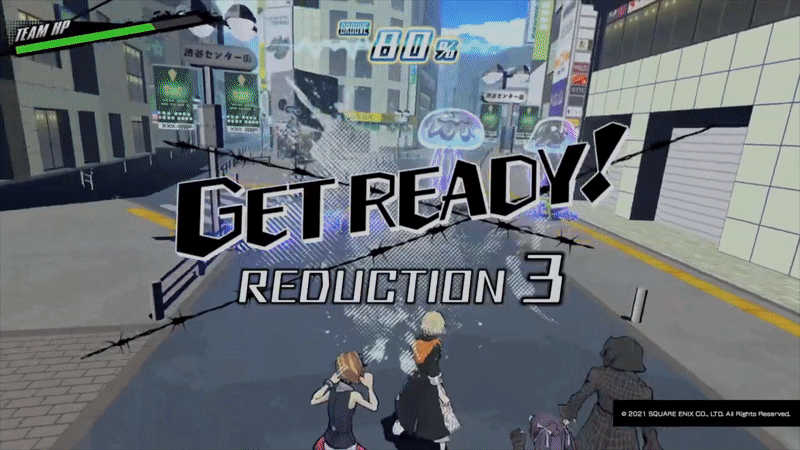This is part two of an analysis on the boss design of The Legend of Zelda: Majora’s Mask and its remake. Part one can be found here.
Something I’d like to talk about while reviewing these last two bosses is the utility of bosses in general. Rather, what design goals are you fulfilling by including a boss? People love bosses, but why? They tend to be notable spikes in gameplay intensity marking the end of a chapter, level, or other extended segment. Bosses can serve a number of functions be it as a narrative component, accentuating a certain gameplay mechanic, simply being a restrictive challenge, among many others. Considering the design goals of a boss helps keep the experience focused and in-line with what you’re trying to design. I’m going to look at these next two bosses through this lens.
Gargantuan Masked Fish Gyorg is next on the chopping block. As his name implies, this beast will fight you primarily from his home in the water. The fight takes place in a large, deep pool with a single round platform in the center raised just above the water’s surface for the player to stand on. At this point in the game the player will also have access to the Zora form, a power which allows them to breathe and maneuver adaptably underwater by running along the pool’s bottom or swimming at high speeds like a dolphin. I’d definitely call Gyorg the weakest of the original N64 Majora’s Mask boss fights. With very little going on, and a rather disruptive camera, I never find myself looking forward to fighting him.

N64 Gyorg’s fight is kind of confusing, to be honest. While the fight is completely player-directed, it’s also not always clear exactly what you need to be doing in this fight. If you stand on the central platform, Gyorg flails about and tries to knock you off, indicating clearly that you’re meant to fight him in the much more spacious pool, although blind-firing arrows at him with your bow from dry land is also possible. The camera is not very kind when it comes to this method, however. You seem to be punished for not being in Zora form, and once in Zora form Gyorg still just seems to swim aimlessly, occasionally going for a bite at you. There’s so little structure to this fight that one can just sort of… try things out, most of which will only kind of work. What I think you’re supposed to do is use the Zora form’s boomerang ability to stun him.. Then use it again while he is stunned to damage him. He has a weak point you need to hit, but it is targeted automatically if you use the targeting mode. A little odd, a little unclear. If you get the timing right, you can stun lock Gyorg forever and there basically is no boss fight. Get it wrong, and you’ll be seeing a lot of the inside of Gyorg’s mouth in rather frustrating fashion. The problem is, while the targeting mode tries to frame the camera, Gyorg’s wildly moving body will swing it around in an abrupt fashion. Unfortunate, since using the targeting mode is the ideal way to attack him. After he takes some damage, he will release a swarm of small fish to attack you, though they can be largely ignored as one continues to stun-lock Gyorg.
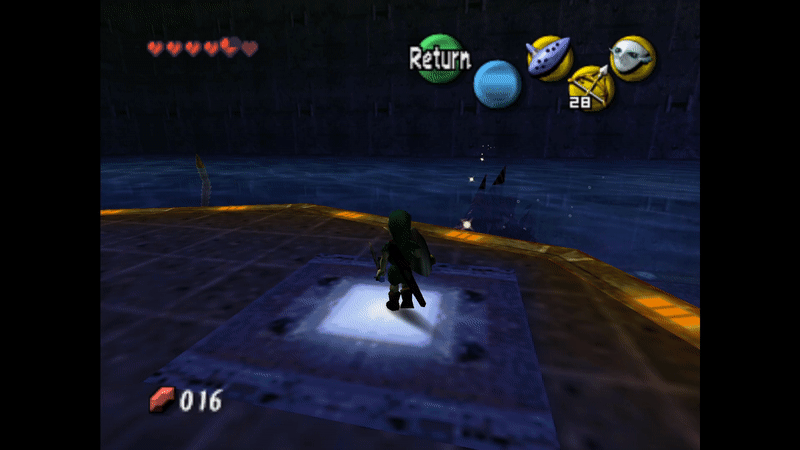
The total lack of structure in this fight makes me wish it was more environment-directed, and makes me question what the design goals with this fight are. It does not utilize this dungeon’s item at all, nor is it very friendly to using most of the Zora’s powers. Swimming at Gyorg can potentially harm him, but I wouldn’t recommend it. It’s not very fun or effective to do. Since actually swimming is not much involved in this fight, it doesn’t really serve as a capstone to the mechanics of the dungeon its found in either. Gyorg is a bit of a low point for me in Majora’s Mask, not providing much by way of narrative, challenge, or mastery for the player. The most effective strategy “throw boomerangs at him repeatedly”, does not make much intuitive sense, and goes to show how some environmental-direction, either through the boss’s actions or the area they are fought in, can help make a fight’s design goals clearer and more effective.

3DS Gyorg sees a lot more structure and direction by the environment in his boss fight, to become a much more effective boss in my opinion.
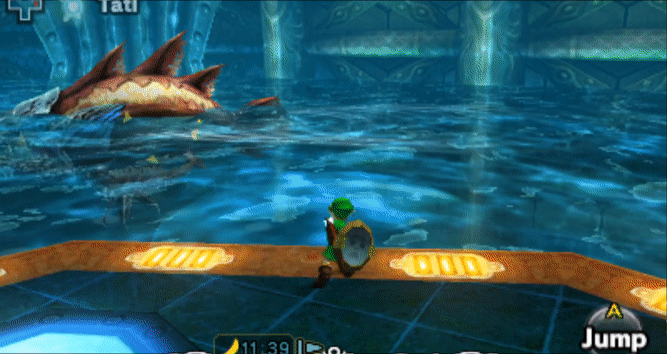
Once again we have that obvious orange eyeball-weakspot, but also a notable change to Gyorg’s design. Before his body was a continuous color but now his face is a notable stony gray in contrast to a softer looking red-orange body. The structure of the fight is being communicated. On the 3DS it’s a lot more clear what you’re actually hitting; anything besides Gyorg’s mask. It’s the mask that’s armored, but not his body, indicating it is vulnerable. The camera has been improved immensely when it comes to shooting Gyorg with the bow and arrow. He now jumps into the air or swims along the surface of the water like a shark, framing his bright orange body nicely against the blue arena for some bow shots. It’s a lot more satisfying already. It works so well it seems as though fighting Gyorg from the land is the intended method, although the Zora also still works like in the old game.

This time, once Gyorg has taken enough damage, the land disappears, forcing the player to engage as a Zora. The implementation of the Zora’s gameplay mechanics are still not stellar in this part of the fight, but it’s a marked improvement over the original game. Here, the Zora’s swimming ability is incentivized to quickly release sea mines, whose very presence is a good clue as to what the structure of this fight is. Gyorg will often open his gullet to try and suck you in, but will suck in any stray mines instead, stunning him and opening him for attack.
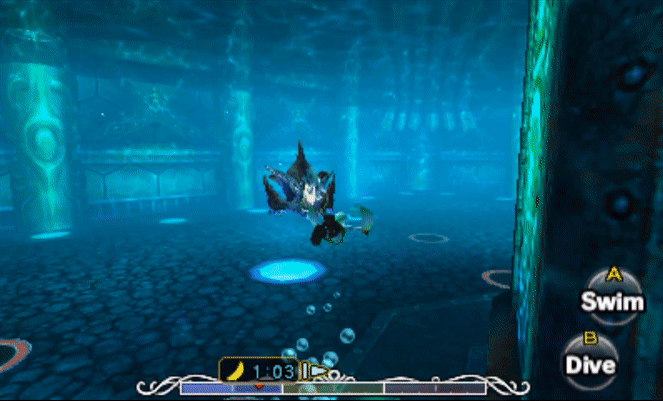
This phase is a little janky as the timing for getting Gyorg to start inhaling and releasing a mine is rather narrow and doesn’t feel as smooth as the mechanics of many other Zelda bosses. Still, overall the changes to Gyorg make him feel like a much more complete experience that actually utilizes mechanics from his dungeon such as the Zora swimming. There’s a lot more variety and feedback for what you should actually be doing. If the design goals here were to engage the player to think about how to adapt to an aquatic foe, it succeeds on that front. I’d give the 3DS version of Gyorg a solid thumbs up over his predecessor.
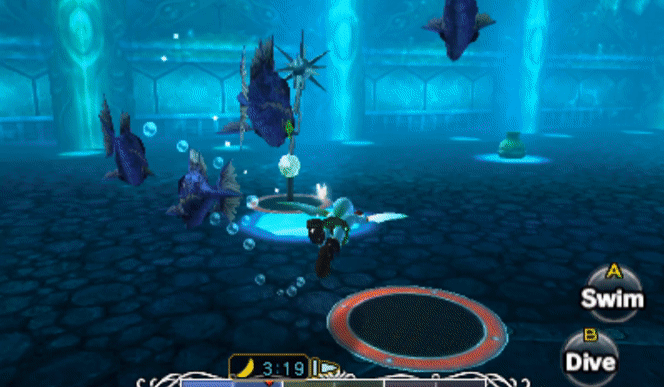
The final boss I’ll be talking about from Majora’s Mask is the Giant Masked Insect Twinmold. With a somewhat misleading yet somewhat appropriate title, Twinmold is actually two giant masked centipede… worm… things, plural.
The original Nintendo 64 version of this boss fight is extremely open ended, extremely player-directed. There is a special dungeon item you obtain in the hours leading up to Twinmold’s confrontation, but it, like many such items before it, in Majora’s Mask is entirely unnecessary to defeating its dungeon boss. Although you are clearly intended to use it. In fact, Twinmold’s boss room is the only location in the game in which that special item, the giant’s mask, can be used. It grants the player titanic proportions, using some visual trickery to transport the player to a scaled-down version of the boss arena inhabited by scaled down Twinmolds that can be much more easily reached with your now colossal sword.
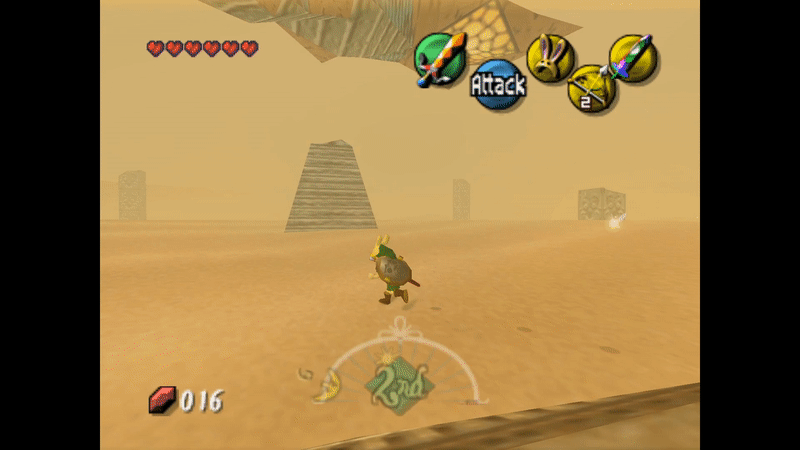
Whether you decide to don the giant’s mask or not, the concept of this boss fight is extremely simple; Twinmold is invulnerable everywhere along its long body except at the head and tip of its tail. The player’s goal is to strike the head and/or tail of each Twinmold until they die, while avoiding their sharp, undulating bodies. If the player is using their limited magic to do so, such as in utilizing the giant’s mask, they must keep on eye on this magic resource and shrink back down to normal size in order to replenish, risking some greater threat to their health in the process. It’s a straightforward rule set borrowed from previous 2D Zelda games where fighting a giant worm meant aiming for its constantly-moving tail, but adapted to 3D space. It works really well! Rarely are you required to keep exact stock of the player’s sword in 3D space in this way, so it’s refreshing and interesting.
I quite like this iteration of the Twinmold fight. It’s simple, but after the difficult and daunting experience that is their home dungeon, it’s a bit refreshing to just stroll up with this huge amount of power in the giant’s mask and let loose. It seems that, along with spectacle, power fantasy was a major design goal of Twinmold, specifically the power fantasy of gaining the might to outmatch an overwhelming evil, as is often the case with Zelda. It’s a bit of relief from the high-intensity part of the interest curve that makes up much of Majora’s Mask’s later stages. Twinmold is not very difficult, but it is very satisfying and momentous. With the final of four major evils stricken from the world, it feels as though the player has truly accomplished something great. Giving them the freedom to completely direct the boss fight helps reinforce this, by making it a labor of their own agency.
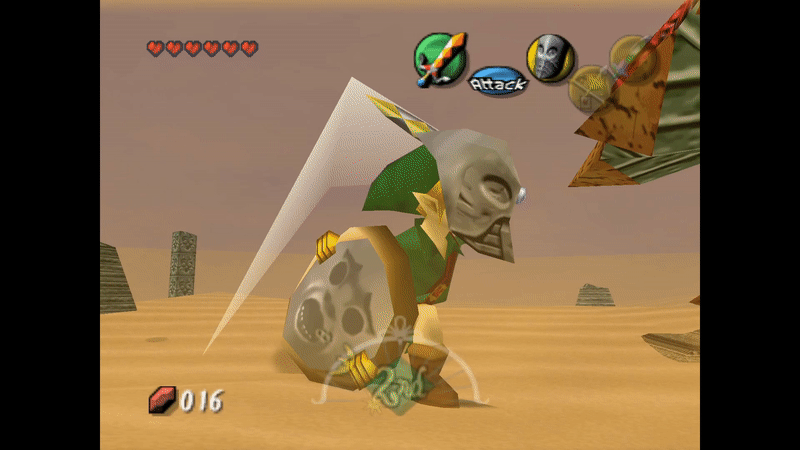
3DS remake Twinmold works quite a bit differently. The fight is now a two-phase affair. In the first phase, the player will not have access to the giant’s mask. On the Nintendo 64 this mask was obtained within the dungeon itself. On the 3DS, the mask is obtained after defeating one of the two Twinmolds. This first Twinmold prefers to fly overhead, and has those large orange eyeball-weakspots on its underside. Shooting it with light arrows will take it down. While shooting, the player must be cognizant of the other Twinmold, which will shell the ground with fire balls.
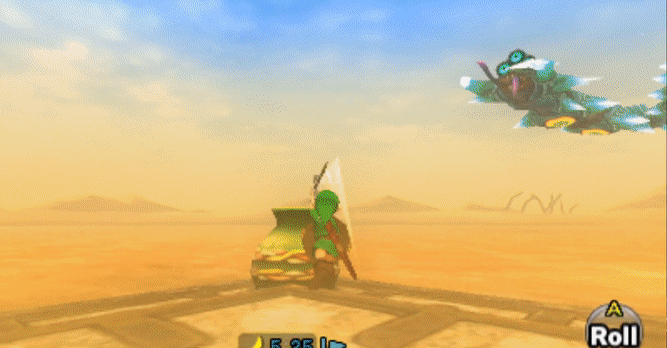
Now, fighting Twinmold without the giant’s mask on the Nintendo 64 is very fun but very daunting. It’s difficult, requiring the player to be constantly aware of their surroundings to quickly position themselves such that they can reach Twinmold with their attacks. The concept of having to defeat one Twinmold against all odds as a tiny normal-sized person before getting the giant’s mask and unleashing overwhelming force against the second is an appealing one. It builds tension and anticipation of the fight to come, adds some nice challenge to this late-game boss, and makes that ultimate power fantasy all the sweeter. It’s a good change in isolation, though I do wish this first phase on the 3DS was more player-directed, with less reliance on those eyeball-weakpoints, which at this very late stage of the game feel somewhat passe. Having to defeat Twinmold in the same fashion as both a human and a giant would better highlight the contrast between the experiences.
3DS Twinmold’s biggest problems come in the form of the changes to the giant form. Giant form on the N64 controls exactly the same as normal form, you’re just now giant, with reach to match. On the 3DS, however, you become lumbering, slow, and very limited in your moveset. You no longer have access to your sword, instead punching the air in front of you with each press of the attack button. This form on the 3DS just does not feel good to play. It’s cumbersome, difficult to position correctly, and frustrating to hit your targets with. Twinmold is no longer vulnerable on the head and tail, and instead punching it anywhere along its body is viable, presumably because positioning the giant form is so difficult that were the old vulnerabilities in play it would be nigh-on impossible to connect any attacks with Twinmold.

Since the player can barely move as a giant, the fight is almost the antithesis of the open-ended fight of the N64, with the player constantly waiting for Twinmold to swing by in a fashion that will allow the player to hit them without accidentally meandering into Twinmold’s spiky body and getting knocked onto the ground. There are also some boulders the player can throw, but you will once again have to wait for Twinmold to hold still in order for them to do anything, and once those boulders are gone, they’re gone. The result is a fight whose exceedingly sluggish flow is determined by the environment, where the player is stuck in a frankly frustrating and unwieldy control scheme unlike anything else in the game.

The fight also lasts forever. This is just a tuning problem – Twinmold clearly has too much health – but I nonetheless became exceptionally bored by the time I had swung Twinmold around like one of those fuzzy worm toys for the fourth time. Where the previous Twinmold’s design goals were clear the 3DS version’s seem somewhat muddied and confused, with good ideas being overshadowed by frustrations and missteps. There’s no power fantasy here, and little sense of awe either. The first Twinmold’s weakness is too obvious, and the second Twinmold is too frustrating.
A mixed bag is how I would describe the remade Majora’s Mask bosses, ultimately. In my estimation, Odalwa is a bit of a step back, Goht has some improvements and some awkward changes, Gyorg is a clear improvement but by no means perfect, and Twinmold is an overall inferior experience despite some good ideas. Aside from my opinion of quality, however, I hope comparing and contrasting the surprisingly different ways all the versions of these bosses were designed helped highlight some of the things to be thinking about when designing bosses. How in control does the player feel? What design goals is your boss meant to fulfill and do they make good on that? Odolwa made me feel the rush of a life or death battle against a swordsman wielding inhuman powers, but some of that is lost if you make the methods by which you can fight him too restrictive. On the opposite end, Gyorg’s confused and meandering original boss fight was markedly improved by the introduction of some structure and environmental cues. Boss design is a deep and broad topic that I’ve only scratched the surface of, but looking at all these different boss designs have given me a lot to think about.

You’re the bad guy. And when you’re bad, you just run. That’s fine, right?
